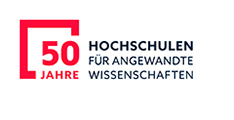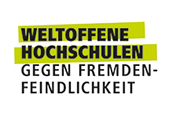Rotational Rheometer MCR 302e, Anton Paar
The rotational rheometer offers various testing options for characterizing the flow behavior of different materials. Among other things, the device is used to determine the viscosity curve of polymer melts using plate-plate geometry, providing information about the processing properties of the material and its thermal stability. The device is also equipped with modules for characterizing the flowability of powders using a shear cell and a Powder Flow Cell (PFC 10). This allows conclusions to be drawn about the processability of polymer powders in 3D printing by SLS. In addition, torsion test geometries can be used to investigate the dynamic mechanical behavior of solid materials.
Technical data:
- Test temperature range up to a maximum of 600°C
- Heating rate up to 30°C/min
- Torque range 1 nNm – 230 mNm
- Oscillation frequency 0.2 µHz – 100 Hz
- Normal force range ± 50 N

HSHL
Universal testing machine 5967, Instron
The universal testing machine is used to determine the mechanical properties of test specimens by controlled movement of a crosshead while simultaneously measuring the applied force. Tests can be performed under tensile, compressive and bending loads. In addition, various test fixtures are available for standardized test specifications, such as the dart drop test. Using the software, the force application and deformation of the specimens can be specifically adjusted, enabling not only quasi-static testing but also more complex conditions such as relaxation, creep and hysteresis.
Technical data:
- Maximum load 30 kN
- Test speeds up to 1000 mm/min
- Maximum travel distance 1500 mm
- Maximum test temperature up to 350°C
- AVE2 video extensometer

HSHL
Pendulum impact tester CEAST 9050, Instron
The pendulum impact tester is used to determine the dynamic impact properties of samples, providing information about their fracture behavior and energy absorption capacity. The device allows standardized testing of impact strength of notched and unnotched specimen according to Charpy. It is equipped with a high-speed data acquisition system, allowing the evaluation of force-time and force-displacement diagrams.
Technical data:
- Impact hammer with 5 J and 25 J
- Test device for Charpy measurements
- Test temperature range from -60°C to room temperature
- Instrumented with 4 MHz data recording and motorized

HSHL
Dynamic mechanical analyzer DMA 242 E Artemis, Netzsch
The dynamic mechanical analyzer (DMA) enables the measurement of the dynamic properties of test specimens using various fixtures for tensile, compressive, bending and shear loading. The device is used, among other things, for characterizing material behavior under long-term loading, measuring the temperature dependence of material response, and identifying transition points such as the glass transition in polymeric materials.
Technical data:
- Fixtures for tensile, compressive, bending and shear loading
- Test temperature range from -170°C to 600°C
- Maximum Load: 24 N
- Frequency range from 0,01 to 100 Hz
- Heating rate up to 20 °C/min

HSHL
Drop test rig, custom-built
The drop test rig enables the investigation of impact loads on larger objects, simulating stresses similar to those occurring during a fall. The aim is to measure the energy absorption capacity of various product groups, such as personal protective equipment in sports and leisure applications. In addition, the device is used to evaluate the energy absorption of cellular materials such as foams or additively manufactured lattice structures.
Technical data:
- Drop height up to 2 m
- Drop weight up to 5 kg
- Impact energy up to 100 J
- Force measurement range up to 70 kN with a sampling rate of 20 kHz
- Test fixtures for standardized testing, including shoulder and shin protectors

HSHL
Drop test for measuring of the energy absorption using a back protector (left) and an impact sound insulation panel (right) as examples. While the protector absorbs the impact energy and stops the falling weight, the hammer is elastically rebounded by the insulation panel (absorbing very little energy).
Differential scanning calorimeter DSC Polyma 214, Netzsch
The differential scanning calorimeter (DSC) enables the measurement of energetic changes in small samples, providing insights into various material properties. Typical applications include determining melting, crystallization and glass transition temperatures, as well as melting and crystallization enthalpies. This information is import for assessing processing and service temperatures, evaluating thermal stability (OIT, oxidation induction time), and detecting changes at the molecular level.
Technical data:
- Temperature range from -70°C to 500°C
- Heating rates up to 100 °C/min
- Measurements under nitrogen and oxygen atmosphere
- Automatic sample changer

HSHL

DSC signal of a powder mixture of used and fresh material for SLS 3D printing, showing distinctly different melting temperatures (peaks)
Thermogravimetric analyzer TG Libra 209 F1, Netzsch
The thermogravimetric analyzer /TGA) enables continuous measurement of the mass of a sample during controlled heating. Decomposition processes occurring during heating can be identified from mass loss, providing insights into the composition of investigated samples. The TGA is uses, among other applications, for the qualitative and quantitative detection of additives in polymer composites whose decomposition temperature differs significantly from that of the polymer matrix (e.g., glass fibers, carbon fibers, ceramic whiskers).
Technical data:
- Temperature range up to 1100°C
- Heating rate up to 100 °C/min
- Maximum sample weight 2 g
- Automatic sample changer
- TGA resolution 0,1 µg

HSHL

HSHL
TGA measurement for determining the glass fiber content of a unknown polypropylene (PP) sample. Red curve: reference measurement with pure glass fiber – no or negligible thermal degradation. Yellow curve: reference measurement with pure PP – almost complete thermal degradation. Green curve: sample with unknow glass fiber content – determination of a glass fiber mass fraction of 25%
High-pressure capillary rheometer CEAST SR50, Instron
The capillary rheometer is used to measure various material parameters of polymers that provide insights into their thermos-mechanical behavior. These parameters are particularly relevant for characterizing flow behavior and thermal expansion under high pressures and shear rates, as encountered during injection molding, and are essential for the simulation-base design of molding processes. The capillary rheometer at the university is equipped with several modules for determining the following material properties:
Viscosity curves of polymer melts at high shear rates
- pvT-behavior
- Thermal conductivity
- Melt strength
- Die swell ratio
Technical data:
- Temperature range up to 450°C
- Force range up to 50 kN
- Shear rates up to 4,000,000 1/s
- Configuration with two barrels

HSHL
Light microscope Axio Imager.M2m, Zeiss
The light microscope is used to visualize specific sample regions at high magnification, providing insights into the structure of the smallest features. Applications include the examination of metallographic cross-sections, the analysis of fracture surfaces of mechanically tested components, and the investigation of structural features in additively manufactured samples. The microscope enables imaging in reflected light (brightfield, darkfield) and transmitted light, optionally with polarization filters. In addition, it can be coupled with a Linkam LTS420 hot stage for studying temperature-dependent structural changes.
Technical data:
- Magnification up to 1000x
- Motorized stage for panoramic imaging and depth-of-field correction
- Comprehensive software for structural measurements

HSHL
Axio Imager light microscope in the materials science laboratory

HSHL
Fracture surface of a bending-loaded specimen with fiber glass reinforcement. Dark area indicate fiber pull-out due to insufficient matrix adhesion.
FT-IR microscope LUMOS, Bruker
The FT-IR microscope enables the analysis of the molecular structure of organic samples by examining their interaction with infrared light. This spectral fingerprint can be compared against libraries for material identification. This device is used, among other applications, for chemical mapping of samples with unknown molecular structures and for investigating the mixing rations of polymer blends (band analysis, miscibility studies). Measurements can be performed in different modes, depending on the sample form (ATR, transmission, reflection). The instrument software provides extensive options for data visualization, such as 3D and 4D representation (contour plots, flase-color mapping).
Technical data:
- Spectral measurement range: MIR 4000 to 650 cm-1
- Motorized stage for mapping measurements
- Liquid nitrogen-cooled MCT detector
- Measurement modes: ATR, reflection, transmission

HSHL

HSHL
FT-IR mapping of a PP/PBT blend to assess homogeneity within a granule. Top left: heatmap showing the PBT content in the blend. Top right: region with high (green) and low (orange) PBT content







